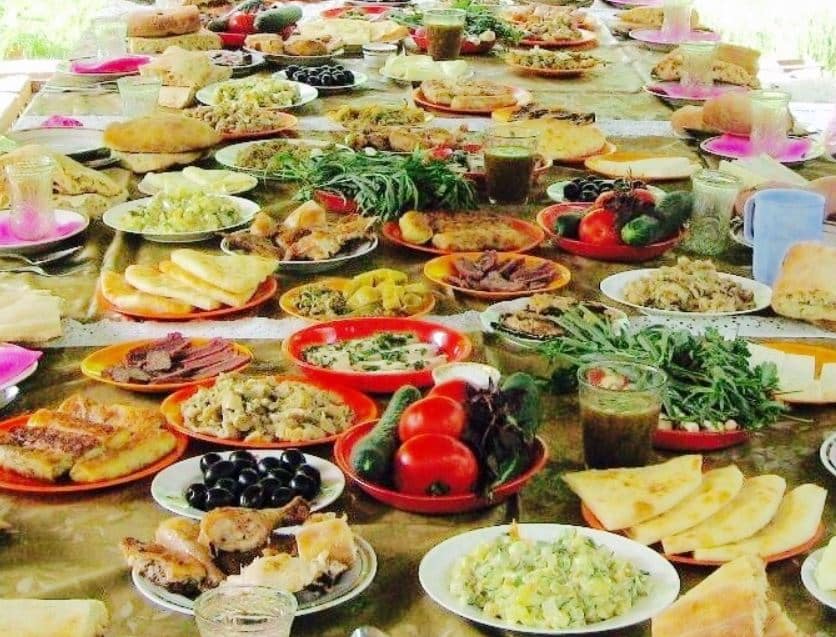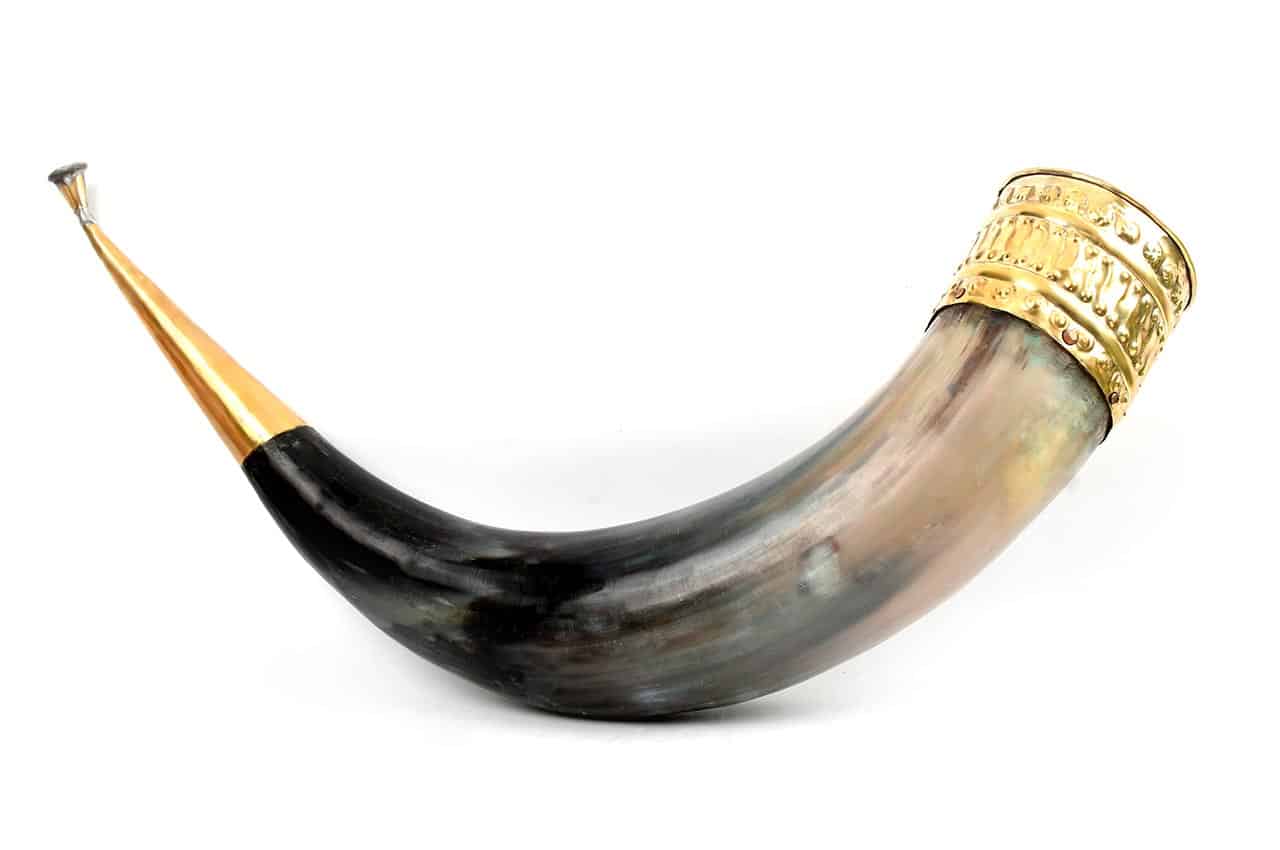In the amazing country of Georgia, a Supra (Georgian: სუფრა) is a traditional Georgian feast and an important part of Georgian social culture. Georgian wine (some of the finest in the world!) flows freely and several to several dozens of courses of food come out throughout the night, followed by dancing. A supra can go until 2 or 3 in the morning!
There are two types of supra: a festive supra, called a keipi, and a sombre supra, called a kelekhi, that is always held after burials.
In Georgian, “supra” means “tablecloth”. It’s likely related to the Arabic sofra (سفرة) and Turkish sofra, which are both words for traditional eating surfaces. Large public meals are never held in Georgia without a supra; when there are no tables, the supra is laid on the ground.
At a supra, toasting is a high art and I believe Georgians have elevated it more than any other culture in the world! What follows is how that toasting process, contest and history are all showcased during a supra.

Hang on, ! I share it with you in the hopes that you will throw a supra of your own, complete with toasts and the many Georgian recipes found here at TFD!
Here we go! 🙂
Regardless of size and type, a supra is always led by a tamada, or toastmaster, who introduces each toast during the feast. The tamada is elected by the banqueting guests or chosen by the host. A successful tamada must possess great rhetorical skill and be able to consume a large amount of alcohol without showing signs of drunkenness.
During the meal, the tamada will propose a toast, and then speak at some length about the topic. The guests raise their glasses, but do not drink. After the tamada has spoken, the toast continues, usually in a counter-clockwise direction (to the right).
The next guest who wishes to speak raises their glass, holds forth, and then drains their glass. If a guest does not wish to speak, they may drink from their glass after some words that particularly resonate for him or her. Eating is entirely appropriate during toasts, but talking is frowned upon. Once everyone who wishes to speak on the theme has done so, the tamada proposes a new toast, and the cycle begins again.
While some more of the more important toasts require drinking your glass to the bottom as a sign of respect (bolomde in Georgian), the traditions of the Georgian table space the drinking out over the course of the meal.
Here are the rules. You cannot drink until the tamada (toastmaster) has made his toast and drinks. Only then, and usually in order around the table, can other revelers repeat the toast and drink. Never propose a different toast unless you are given permission: that is an offense to the tamada.
If the toast is made to you as a visitor, to America or England, to the President or the Queen, or in any way bears directly upon your presence, you must wait to drink until everyone else has gone before you. Your toast in response should be one of thanks.
Occasionally you will hear the tamada say “Alaverdi” to someone. This means that one guest has been chosen to elaborate the tamada’s toast. All other present then drink to this same theme.
While it may appear curious to some Western folk, Georgians take their traditional toasting very seriously. There is a structure and balance to a Georgian toast.
Etiquette
Toasts are made with either wine (usually) or brandy (occasionally, either local or imported), and nothing else – toasting with beer is a TERRIBLE insult!
If you are being toasted, you are supposed to wait until the tamada has finished, then stand up and thank the toaster. Then, you should wait until everyone else is done before drinking your wine in one go. If the tamada says Alaverdi! to you, you should elaborate on his toast. If a large ram or goat’s horn (called the khantsi) is brought out during the meal and filled with wine, then an honored guest – perhaps you – is supposed to drink it to the bottom.
If someone else is being toasted, the easiest advice is to wait until everyone else is drinking to drink your wine. Other than that, it’s good advice to be quiet while the tamada is talking, and remember the various other rules of etiquette in Georgia, some of which are, not putting feet on the furniture and not chewing gum in public.
The proper response to Georgian toasts is “gaumarzos”, meaning literally ‘to your victory’; pragmatically it is equivalent to ‘cheers.’
Immediately after the toast, people clink glasses with the tamada. Normally, when a foreigner is present, the tamada starts with a toast to long-lasting friendship with him or her.
Traditions and national values are frequently mentioned. Every foreigner is paid the compliment of being a good representative of his or her country, and is assumed to be proud of this. The second toast could be to the guests’ home countries, to their families, or to family in general. Toasting mothers is obligatory, as is toasting friendship, deceased relatives, existing and future children, peace, love, and the hostess.
The tamada can combine topics into one toast, or split topics into several toasts. The more people present, the more formal the toasts. At evenings with close friends, the toasts are often quite witty and short. The course of toasting follows a variable thematic canon, which is accommodated to the specific occasion.
The pattern of marriage toasting is different from the pattern appropriate for toasting the birth of a child. Education, rhetorics, and a good sense of humor can all be demonstrated while delivering a toast. On a typical lxinis supra (happy banquet) with guests, the thematic sequence of toasting progresses approximately in the following fashion:
(1) To our acquaintance and friendship,
(2) to the well-being of the guests, relatives and friends,
(3) to the family of the guests,
(4) to the parents and the older generation,
(5) to the dead and the saints, (wine is poured onto a piece of bread for this toast)
(6) to existing and yet unborn children,
(7) to the women present at the table,
(8) to love,
(9) to the guests’ mothers,
(10) to peace on earth,
(11) to the hostess,
(12) to the tamada himself.
The toast to the hostess, (normally the one who has prepared the meal) is usually the penultimate or last toast, and has certain implications for ‘opening up the closing’ of the evening.
When such a toast is about to be offered, frequent attempts to delay its delivery can be observed, since this toast would end the evening. The time-order of the entire evening is thus reflected in the pattern of toasting. To a certain extent, every evening is prestructured by the pattern of toasting.
The following order for toasts is typical for a ciris supra (funeral banquet)
(1) To the tamada
(2) to the person who has died,
(3) to his or her spouse (if dead),
(4) to the person’s parents (if dead),
(5) to the person’s grandparents (if dead),
(6) to the person’s other dead relatives,
(7) to people from Georgia who died in the war,
(8) to Georgians who died abroad,
(9) to families who have no descendants and whose names are lost,
(10) to the spouse of the deceased (if living),
(11) to the children of the deceased (if living),
(12) to the surviving parents,
(13) to the surviving siblings,
(14) to the surviving relatives,
(15) to the surviving friends and neighbors,
(16) to the other members of the supra,
(17) to people who have been good to the family of the deceased.
Important toasts are marked by a shift of position. Whereas the tamada and all the other men rise to their feet, the women remain seated. Additionally, the relevance of a specific toast is indicated by the appropriate quantity of wine that is to be drunk in one gulp after its deliverance, and by the drinking-vessel used (glass vs. horn).
Drinking a lot of alcohol is considered a necessary component of displaying masculinity. Since the tamada is required to empty his drinking-vessel completely after every toast, he must possess a high tolerance to alcohol – particularly on special occasions, when drinking-vessels are used made out of bull horns, with a mouthpiece adorned with silver fittings.
Talking stops when the tamada begins to give a toast. To continue talking is considered impolite. At a supra, informal talking is hardly possible, because the themes to be talked about are pre-structured to a certain degree in accordance with the canonic order of toasting.
Discussions keep getting interrupted by a toast. The tamada manages to start the toasting by suddenly raising his glass and calling a formula, or xalxo (folks), or some personal form of address. Anyone speaking is then expected to stop in order to listen to the tamada. The toast normally stands out distinctly from other talking activity by gestures, intonation, position shifting, and addressing.
Although the toasts are well-known over generations, there is never one toast like the other. The tamada produces performances that are similar rather than identical, as is typical for oral genres. Changes from one concrete performance to the next are determined by the preferences of the individual speaker, his perception of the audience’s taste, and sometimes by the audience’s open reaction. The audience is constantly taken into consideration.
There is no formal teaching in how to give a toast; one trains to become a good toast giver by listening to the toasts given at the table. People talk about the toasts delivered during an evening later on. The evaluation of special toasts is also a common theme. Criteria of judgment include the manner of delivery, the balance of traditional and creative performance features, the fluency of speaking, and the sensitive finding of social qualities to praise.
When a marriage is discussed, one necessarily also talks about the excellence and originality of the toasts presented on that occasion. Excellence is judged by the perfect fulfillment of the generic norms, while originality is judged by the creativity used within the given procedure. Both should be optimally matched.
Praise to the people present and to those absent is a central function of the toasts. Since praise is a social endeavor, the tamada has to be a good social observer. The person who is the subject of the toast is honored by the whole group; thus, the genre helps to establish and re-establish social bonds and norms. To be a good tamada demands close observation of the surrounding social world.
By praising known and unknown qualities of living and deceased people, a good tamada shows that he is more than simply a man of words. He is the one who makes people see new dimensions of the subject, and who keeps the memory of the deceased alive.
The tamada has to guarantee that the dinner ends with good feelings among all the participants, a goal that is highly valued by the Georgians.
Formulae are used in every toast, and there is a fixed set that provides a stock for every tamada, for example, me minda semogtavazot, sadvegrzelo (I want to offer you a toast), kargad qopna (to their well-being), zanmrteloba vusurvot (I wish them health), bedniereba vusurvot (I wish them good luck), msoblebs dagilocavt suqvelas (I bless all your parents/best wishes for all your parents), vmertma gaumarzos suqvelas (God shall give all of them his favor).
However, a toast that consists only of formulaic phrases is considered to be a poor one. A good tamada combines traditional and creative phrases. He can give voice to his own individuality, and at the same time be sensitive to the audience’s pleasure.
Alaverdi
A ritualized toast-competition, called alaverdi, is often established between the men at the table. The tamada talks about a specific topic, and the other men must modify this topic in the subsequent toasts.
When one alaverdi round is completed, the tamada must decide who will open the next round. His decision should be based on the criteria of the toast’s originality, its formulation, and the approval it received from the table. Table rhetoric is considered to be an important sign of masculinity. Men who cannot take part are considered unmanly.
In the special form of alaverdi toasting competition, the tamada symbolically grants other men his power of speech. To whoever he hands the drink-horn or the glass, becomes temporarily the tamada, and as such, the center of attraction of the dinner-party. He is then expected to vary and elaborate the topic already determined by the head-tamada.
In formal contexts, the competition is about ‘who is the best.’ The head-tamada, taking into consideration the approval of the people present, judges who was best. In the next round, the winner is given the right to speak as the second tamada. It is frequently very obvious that the head-tamada himself was the best, and he laboriously tries to remain in that position.
The audience at the table can express their appreciation of specific toasts by paying compliments, clapping, or making non-verbal gestures (however, this does not occur in the following example). In alaverdi-drinking, it becomes especially apparent that the power of words is a sign of masculinity in Georgian culture.
Article source: www.thefooddictator.com







